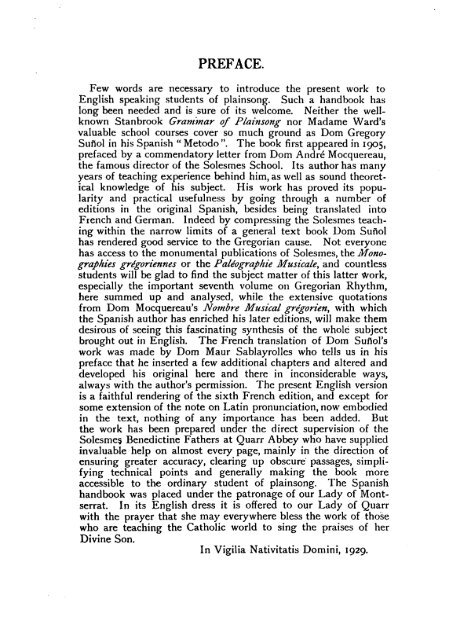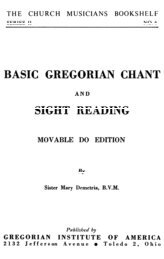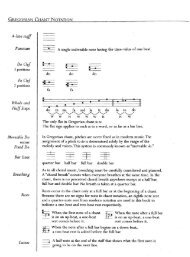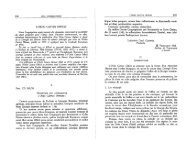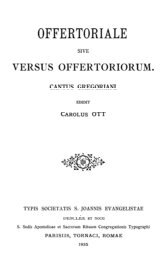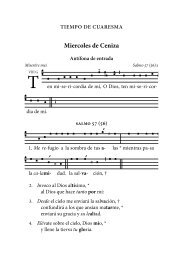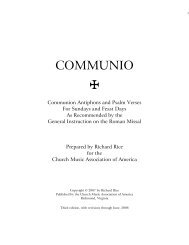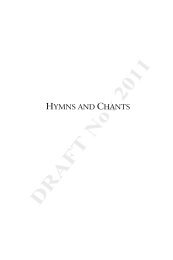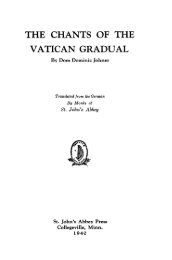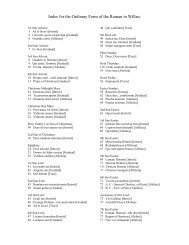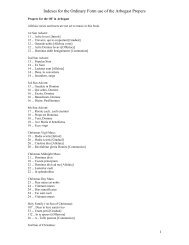Textbook of Gregorian Chant (1930) - MusicaSacra
Textbook of Gregorian Chant (1930) - MusicaSacra
Textbook of Gregorian Chant (1930) - MusicaSacra
Create successful ePaper yourself
Turn your PDF publications into a flip-book with our unique Google optimized e-Paper software.
PREFACE.<br />
Few words are necessary to introduce the present work to<br />
English speaking students <strong>of</strong> plainsong. Such a handbook has<br />
long been needed and is sure <strong>of</strong> its welcome. Neither the wellknown<br />
Stanbrook Grammar <strong>of</strong> Plainsong nor Madame Ward's<br />
valuable school courses cover so much ground as Dom Gregory<br />
Suflol in his Spanish " Metodo ". The book first appeared in 1905,<br />
prefaced by a commendatory letter from Dom Andre Mocquereau,<br />
the famous director <strong>of</strong> the Solesmes School. Its author has many<br />
years <strong>of</strong> teaching experience behind him, as well as sound theoretical<br />
knowledge <strong>of</strong> his subject. His work has proved its popularity<br />
and practical usefulness by going through a number <strong>of</strong><br />
editions in the original Spanish, besides being translated into<br />
French and German. Indeed by compressing the Solesmes teaching<br />
within the narrow limits <strong>of</strong> a general text book Dom Sufiol<br />
has rendered good service to the <strong>Gregorian</strong> cause. Not everyone<br />
has access to the monumental publications <strong>of</strong> Solesmes, the Monographies<br />
gregoriennes or the Paleographie Musicale> and countless<br />
students will be glad to find the subject matter <strong>of</strong> this latter Work,<br />
especially the important seventh volume on <strong>Gregorian</strong> Rhythm,<br />
here summed up and analysed, while the extensive quotations<br />
from Dom Mocquereau's Nombre Musical gregorien, with which<br />
the Spanish author has enriched his later editions, will make them<br />
desirous <strong>of</strong> seeing this fascinating synthesis <strong>of</strong> the whole subject<br />
brought out in English. The French translation <strong>of</strong> Dom Suitors<br />
work was made by Dom Maur Sablayrolles who tells us in his<br />
preface that he inserted a few additional chapters and altered and<br />
developed his original here and there in inconsiderable ways,<br />
always with the author's permission. The present English version<br />
is a faithful rendering <strong>of</strong> the sixth French edition, and except for<br />
some extension <strong>of</strong> the note on Latin pronunciation, now embodied<br />
in the text, nothing <strong>of</strong> any importance has been added. But<br />
the work has been prepared under the direct supervision <strong>of</strong> the<br />
Solesmes Benedictine Fathers at Quarr Abbey who have supplied<br />
invaluable help on almost every page, mainly in the direction <strong>of</strong><br />
ensuring greater accuracy, clearing up obscure passages, simplifying<br />
technical points and generally making the book more<br />
accessible to the ordinary student <strong>of</strong> plainsong. The Spanish<br />
handbook was placed under the patronage <strong>of</strong> our Lady <strong>of</strong> Montserrat.<br />
In its English dress it is <strong>of</strong>fered to our Lady <strong>of</strong> Quarr<br />
with the prayer that she may everywhere bless the work <strong>of</strong> those<br />
who are teaching the Catholic world to sing the praises <strong>of</strong> her<br />
Divine Son.<br />
In Vigilia Nativitatis Domini, 1929.


